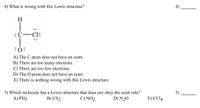
Chemistry
10th Edition
ISBN: 9781305957404
Author: Steven S. Zumdahl, Susan A. Zumdahl, Donald J. DeCoste
Publisher: Cengage Learning
expand_more
expand_more
format_list_bulleted
Concept explainers
Question

Transcribed Image Text:4) What is wrong with this Lewis structure?
H
:C–Cl:
:
A) The C atom does not have an octet.
B) There are too many electrons.
C) There are too few electrons.
D) The O atom does not have an octet.
E) There is nothing wrong with this Lewis structure.
5) Which molecule has a Lewis structure that does not obey the octet rule?
A) PH3
5)
B) CS2
C) NO2
D) N2O
E) CCI14
Expert Solution
This question has been solved!
Explore an expertly crafted, step-by-step solution for a thorough understanding of key concepts.
This is a popular solution
Trending nowThis is a popular solution!
Step by stepSolved in 3 steps with 3 images

Knowledge Booster
Learn more about
Need a deep-dive on the concept behind this application? Look no further. Learn more about this topic, chemistry and related others by exploring similar questions and additional content below.Similar questions
- A. Draw the Lewis Dot Structure of the molecule or ion OF2 B. Find the shape of the molecule or ion OF2 C. Draw the Lewis Dot Structure of the molecule or ion CH2F2 D. Find the shape of the molecule or ion CH2F2 E. Draw the Lewis Dot Structure of the molecule or ion PO3^-3 F. Find the shape of the molecule or ion PO3^-3arrow_forwardWrite Lewis structure that obey the octet rule (duet rule for H) for each of the following molecules. Carbon is the central atom in Ch4, nitrogen is the central atom in NH3, and oxygen is the central atom in H20. a) F2 b) O2 c) CO d) CH4 e) NH3 f) H2O g) HFarrow_forward6. Convert CH3CH₂COOH to a Lewis Structurearrow_forward
- Draw the Lewis structure of the given molecular compounds. 1. HBr 2. Cl2 3. CH. 4. H2CO3 (Both Hatoms are attached to 0) 5. PCI3arrow_forward8)A) Which of the following bonds is least polar or no polar?a) C-Ob) H-Cc) Cl-Cld) Br-Oe) They are all nonpolarB) Choose the compound with the most ionic bond.a) LiClb) KFc) NaCl d) LiFe) CsFC) Which of the following compounds contains only one unshared pair of valence electrons in its Lewis structure?a) NCl3b) H20c) CH4d) NaCle) PH3arrow_forwardQUESTION 6. Using VSPER theory, provide the following information (as in the example below) about each molecule. Central atom is underlined. 1)GaH3 2) OF2 3) SeBr2 4) NCI3 5) SİF4 Example: H20 a) # of bonding groups around central atom = 2 c) Shape = bent b) # of lone pairs around central atom = 2 %3D b= gona! Jong 1) a= C= 2) а- b= 3) а3 b= 4) a= b= C= 5) а%3 b= C=arrow_forward
- Ansarrow_forwardUse Lewis theory to determine the formula for the compound that forms between the two elements listed. Express your answer as a chemical formula. A.) Ca and N B.) Mg and I C.) Ca and S D.) Cs and Farrow_forwardDecide whether these proposed Lewis structures are reasonable. proposed Lewis structure -C=C:] H-C : 0: 0=0=0 [HO] : O OO Is the proposed Lewis structure reasonable? Yes. No, it has the wrong number of valence electrons. The correct number is: No, it has the right number of valence electrons but doesn't satisfy the octet rule. The symbols of the problem atoms are:* 0 Yes. No, it has the wrong number of valence electrons. The correct number is: No, it has the right number of valence electrons but doesn't satisfy the octet rule. The symbols of the problem atoms are:* П Yes. No, it has the wrong number of valence electrons. The correct number is: No, it has the right number of valence electrons but doesn't satisfy the octet rule. The symbols of the problem atoms are:* * If two or more atoms of the same element don't satisfy the octet rule, just enter the chemical symbol as many times as necessary. For example, if two oxygen atoms don't satisfy the octet rule, enter "O,0".arrow_forward
- Chemistry not physicsarrow_forwardBha Please don't provide the handwriting solutionarrow_forward1. Draw the Lewis structure to the following compounds. For each compound, state whether the bonding is covalent, ionic, or a mixture of covalent and ionic. Be sure to indicate any charge on the correct atom. a) C3Hg b) HCIO c) NaCIO d) CH,OH e) NaOH f) CaCl, 8.arrow_forward
arrow_back_ios
SEE MORE QUESTIONS
arrow_forward_ios
Recommended textbooks for you
 ChemistryChemistryISBN:9781305957404Author:Steven S. Zumdahl, Susan A. Zumdahl, Donald J. DeCostePublisher:Cengage Learning
ChemistryChemistryISBN:9781305957404Author:Steven S. Zumdahl, Susan A. Zumdahl, Donald J. DeCostePublisher:Cengage Learning ChemistryChemistryISBN:9781259911156Author:Raymond Chang Dr., Jason Overby ProfessorPublisher:McGraw-Hill Education
ChemistryChemistryISBN:9781259911156Author:Raymond Chang Dr., Jason Overby ProfessorPublisher:McGraw-Hill Education Principles of Instrumental AnalysisChemistryISBN:9781305577213Author:Douglas A. Skoog, F. James Holler, Stanley R. CrouchPublisher:Cengage Learning
Principles of Instrumental AnalysisChemistryISBN:9781305577213Author:Douglas A. Skoog, F. James Holler, Stanley R. CrouchPublisher:Cengage Learning Organic ChemistryChemistryISBN:9780078021558Author:Janice Gorzynski Smith Dr.Publisher:McGraw-Hill Education
Organic ChemistryChemistryISBN:9780078021558Author:Janice Gorzynski Smith Dr.Publisher:McGraw-Hill Education Chemistry: Principles and ReactionsChemistryISBN:9781305079373Author:William L. Masterton, Cecile N. HurleyPublisher:Cengage Learning
Chemistry: Principles and ReactionsChemistryISBN:9781305079373Author:William L. Masterton, Cecile N. HurleyPublisher:Cengage Learning Elementary Principles of Chemical Processes, Bind...ChemistryISBN:9781118431221Author:Richard M. Felder, Ronald W. Rousseau, Lisa G. BullardPublisher:WILEY
Elementary Principles of Chemical Processes, Bind...ChemistryISBN:9781118431221Author:Richard M. Felder, Ronald W. Rousseau, Lisa G. BullardPublisher:WILEY

Chemistry
Chemistry
ISBN:9781305957404
Author:Steven S. Zumdahl, Susan A. Zumdahl, Donald J. DeCoste
Publisher:Cengage Learning

Chemistry
Chemistry
ISBN:9781259911156
Author:Raymond Chang Dr., Jason Overby Professor
Publisher:McGraw-Hill Education

Principles of Instrumental Analysis
Chemistry
ISBN:9781305577213
Author:Douglas A. Skoog, F. James Holler, Stanley R. Crouch
Publisher:Cengage Learning

Organic Chemistry
Chemistry
ISBN:9780078021558
Author:Janice Gorzynski Smith Dr.
Publisher:McGraw-Hill Education

Chemistry: Principles and Reactions
Chemistry
ISBN:9781305079373
Author:William L. Masterton, Cecile N. Hurley
Publisher:Cengage Learning

Elementary Principles of Chemical Processes, Bind...
Chemistry
ISBN:9781118431221
Author:Richard M. Felder, Ronald W. Rousseau, Lisa G. Bullard
Publisher:WILEY